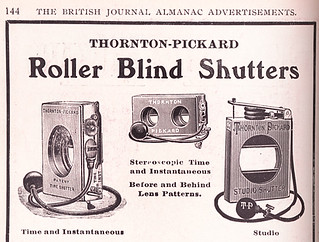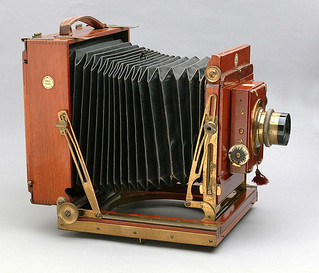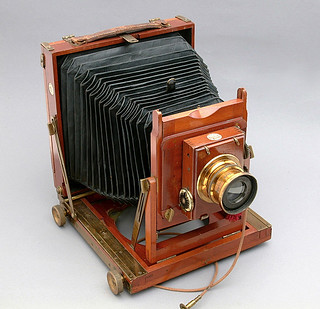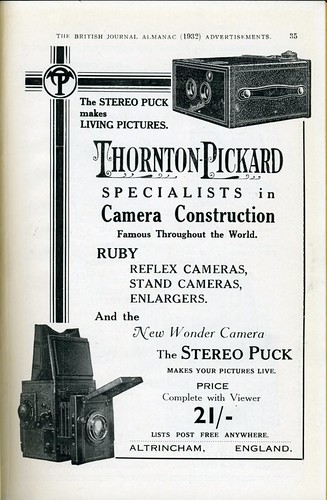Thornton-Pickard

|
| 1916 Advertisement for shutters scanned by Geoff Harrisson (Image rights) |
The Thornton-Pickard Manufacturing Company Ltd. was a camera maker based in Altrincham, Cheshire (later moving to Greater Manchester), UK. It made the famous Ruby and Rubyette hand cameras and the Imperial stand cameras. The company made shutters, both for inclusion in cameras and as separate units to be mounted on any camera. They could be fittted behind the lens or a push-fit onto the front of a lens. Shutters included the patented Panoptic and Ruby shutters,[1] and the Unit focal plane shutters.[2] Many Thornton-Pickard cameras were equipped with Dallmeyer lenses.
Note: many un-named wooden cameras have been mis-identified as Thornton-Pickards because one of their shutters was fitted.
History
From 1880 to 1886 John Edward Thornton (1865-1940) was in an apprenticehip at the renowned printing company George Faulkner & Sons. There he began to work on a new camera (the Jubilee) and the Time roller blind shutter. In 1886 he founded a trading company that sold cameras and shutters. Among these items were those on which he had received patents. They were produced by others. The Jubilee for example was made by Billcliff of Manchester. By 1887 Thornton could present a whole palette of products in a Royal Jubilee Exhibition. At the same time he launched his Thornton Manufacturing Company to take over the production of his shutters and cameras. At the end of that year he held 12 patents. He won engineer and business manager Edgar Pickard (1862-1897) as a partner with whom he relaunched his company as Thornton-Pickard Manufacturing Company Ltd. in 1888. They focused on the production of shutters which were highly in demand, and added the camera model Artist to their other products. Some years later they moved from Manchester to Altrincham. Until then George Pickard, the father of Edgar Pickard, had helped financially to launch the business. For a while they reduced camera production to making only their newest model, the Ruby camera, later adding the Amber.
J. E. Thornton's relations with Edgar Pickard were troublesome, however things became worse for the company when Edgar Pickard died in March 1897 at the age of 35. Edgar Pickard's oldest brother George Arthur Pickard (1850-1919), a business manager, took over the leading role at T-P shortly after its relaunch as public limited company. In May that year he could announce to the company's shareholders' first general assembly a rapid increase of camera sales. The shutter maker had been successfully transformed into a camera maker. Nonetheless J. E. Thornton and G. A. Pickard were in frequent disagreement so that Thornton's departure was announced in an extraordinary general meeting in 1898. G. A. Pickard led the company until his death in 1919.
Thornton's engineering talent wasn't limited to cameras and shutters and he made several new attempts in entrepreneurship. One attempt was to build up a film making business. When he had founded his Thornton Film Company Ltd. he patented a film pack, called 'Daypack'. Rochester Optical Co. expressed interest in this, which resulted in a treaty with Thornton. After Kodak took over Rochester Optical Co. in 1903 Thornton continued to receive royalties for the filmpack. He died in 1940.
Despite of the loss of its two founders the Thornton-Pickard Manufacturing Company Ltd. Photographic Apparatus flourished under G. A. Pickard, becoming a leading British camera maker. With modern machines it could achieve cost reductions in some areas so that some budget camera models could be offered. For example the Imperial Triple Extension Camera was sold as the 17-Shilling-Set. And the Tribune was offered for a guinea as camera for beginners. Later a series of cheap snapshot cameras was added: Snappa, Clipper, and Limit. On the other hand Thornton-Pickard's new flagship series was born: The Ruby Reflex SLRs.
After the First World War there was a hopeful restart when wartime security policies concerning photography ended. After G.A. Pickard's death Arthur Gray Pickard took over the lead. Besides new cameras the company launched the Picabrik construction kit for children. However the 1920s started with a trade depression that turned the company's hopeful restart into its slow decline. The company remained as a maker of quality cameras until its end in 1939. A repair service was kept alive until ca. 1960.
| British companies | ||
| Adams & Co. | Agilux | Aldis | APeM | Aptus | Artima | Barnet Ensign | Beard | Beck | Benetfink | Billcliff | Boots | British Ferrotype | Butcher | Chapman | Cooke | Corfield | Coronet | Dallmeyer | Dekko | De Vere | Dixons | Dollond | Elliott | Gandolfi | Gnome | Griffiths | G. Hare | Houghtons | Houghton-Butcher | Hunter | Ilford | Jackson | Johnson | Kentmere | Kershaw-Soho | Kodak Ltd. | Lancaster | Lejeune and Perken | Lizars | London & Paris Optic & Clock Company | Marion | Marlow | Meagher | MPP | Neville | Newman & Guardia | Pearson and Denham | Perken, Son and Company | Perken, Son & Rayment | Photopia | Purma | Reid & Sigrist | Reynolds and Branson | Ross | Ross Ensign | Sanderson | Sands & Hunter | Shackman | Shew | Soho | Standard Cameras Ltd | Taylor-Hobson | Thornton-Pickard | Underwood | United | Watkins | Watson | Wynne's Infallible | Wray |

|
| Special Ruby 1/2 plate image by Geoff Harrisson (Image rights) |

|
| Imperial whole-plate c.1910 image by Geoff Harrisson (Image rights) |
Camera list
Thornton
- Jubilee
- Cyclum
- Tourist
Thornton-Pickard

|
| Advertisement for Stereo Puck, Ruby Reflex, enlargers & stand cameras in the BJP Almanac for 1932. scanned by Nesster (Image rights) |
- Artist
- Ruby
- Amber
- Royal Ruby stereo camera
- Tribune
- Imperial double- or triple-extension
- Imperial Focal Plane
- Automan
- Totator
- Wafer
- Weenie
- Snappa
- Clipper
- Limit
- Minim
- Royal Ruby
- Imperial Perfecta
- Nimrod Automan hand camera
- Folding Ruby hand camera
- New Folding Ruby No.2
- Focal-Plane Folding Ruby Tropical camera
- Stereo Unit Folding Ruby camera
- Special Ruby
- Imperial Pocket No. 2
- Safety Magazine camera
- Ruby Reflex
- College
- Praetor

|
| 1920 advertisement scanned by Geoff Harrisson (Image rights) |
- Filma (2¼x3¼ box camera)
- Special Ruby Reflex
- Type "A" Aero Camera
- Type "C" Aero Camera
- Type "E" Aero Camera
- Mk. III Hythe Camera Gun
- Imperial Portrait Camera
- Rubyette
- Victory Reflex
- Overseas
- Sports Reflex
- All Weather Press Camera
- Junior Special Reflex similar to Junior Special Ruby Reflex
- Portrait Puck
- Puck box camera
- Stereo Puck
- Rollfilm Ruby
- Ruby Speed Camera
Notes
- ↑ Notes on the Ruby focal-plane shutter at Early Photography
- ↑ Notes on the Unit focal-plane shutter at Early Photography.
Links
In English:
- The Thornton-Pickard Story by Douglas Rendell (pdf) at Altrincham Heritage
- Thornton-Pickard cameras on Wood & Brass Cameras by Eric Evans
- Patents at Espacenet, the patent search facility of the European Patent Office:
- British Patent 1924 of 1895, Improvements in Shutters for Photographic Cameras, granted to John Thornton and Edgar Pickard, and describing a wooden-bodied, self-capping roller shutter for front-mounting.
In French:
- Thornton Cameras at Sylvain Halgand's Collection Appareils
Literature
- Douglas Rendell: The Thornton-Pickard Story, Prudhoe (Northumberland) 1992